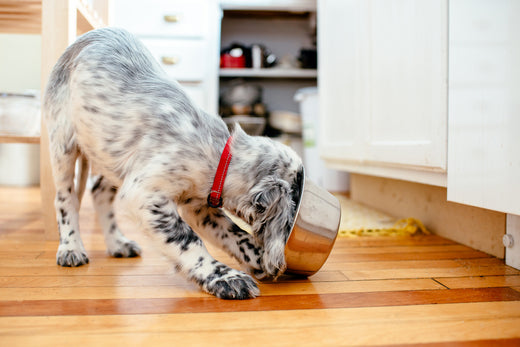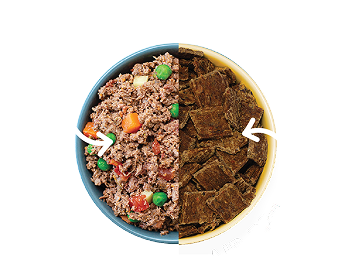
Is Grain-Free Dog Food Better for Dogs?
The short answer: there are both pros and cons of grain-free dog food. It’s just not that simple! However, behind the questions about grain-free dog food are bigger ones about carbohydrates, weight maintenance, and overall health.
Dedicated dog parents like you want to do what’s best for your pup in every aspect of a dog’s life, from play to rest. Of course, you also want to feed your dog in the healthiest way possible. As an informed dog parent, you probably instinctively know that it’s critical to keep your dog at a healthy weight.
It turns out that 60% of dogs are overweight. Just as in humans, eating too many carbs can lead to blood sugar fluctuations, insulin resistance, obesity, diabetes and other health problems in dogs.
Studies have found that feeding dogs to maintain a lean body weight can increase life span by almost 2 years. That’s huge! No wonder we’re thinking hard about what to feed our precious pups! So, do the purported benefits of grain-free dog food make it the ultimate answer for weight control and longevity? Let’s find out.
The grain-free vs. grain dog food debate
Choosing food for your dog can be very confusing. Dog owners often puzzle over questions like these:
- Humans need grains as part of a healthy diet. Does my furbaby need them too?
- On the other hand, grains can be a harmful, allergenic food for humans. Might they also be harmful for my dog?
- When I want to lose weight, my first move is to cut carbs. How should I think about carbs when it comes to my canine?
In debating grain-free dog food’s benefits, it turns out that the easiest way to make an informed decision is to cut through the confusion and just get the right answers to a few questions.
Do dogs need grain-free food?
Not exactly. Grain-free dog food is a popular canine health food trend. Just as there are health trends in people-food — like our current obsessions with meat-heavy Paleo or Keto diet trends — there are similar trends in dog food.
More and more dog owners are “against the grain” because they want to get the supposed benefits of grain-free dog food. Grain-free dog food is billed as better for dogs — because it’s more natural for them, and less likely to cause allergies or other health problems.
That all sounds great, right? Except for the fact that it’s not true.
Just as you can choose foods for yourself that are marked with buzzwords like Paleo or Keto — even ice creams and cookies, mind you — it doesn’t mean you are making your overall diet any healthier. The same can be true in choosing food for your pup - you might be relying on a healthy eating buzzword to inform you on the benefits of grain-free dog food without assessing the true role that food plays in health.
But won’t going grain-free cut carbs?
Remember: just because a dog food is labeled “grain-free” doesn’t mean guaranteed benefits for your pet. If your goal is to protect your pup from becoming overweight, know that many grain-free foods are high in carbohydrates, fat, and calories.
How can this be? The answer is simple — simple carbohydrates, that is. Grain-free dog food is not carb-free dog food. Many grain-free dog foods use legumes, potatoes, tapioca, or sweet potatoes as replacements for whole grains like corn or wheat.
All carbohydrates are sugars. More complex carbohydrates, — like from whole grain wheat, corn, rice, barley, or oats — are absorbed more slowly by your dog’s body. They deliver extra fiber, take a longer time to be digested, and therefore release sugars at a slower pace.
Simple carbohydrates are absorbed fast. These carbs quickly release glucose into your dog’s blood — a phenomenon often referred to as a spike in blood sugar. In both you and your dog, the hormone insulin regulates blood sugar by helping cells absorb the glucose.
But these blood sugar spikes can cause weight gain. When surges of insulin cause your dog’s cells to absorb too much glucose at once, the body converts those sugars into fat.
Choosing grain-free dog food doesn’t solve the issue for your dog — because grain-free dog foods don’t cut carbs in the slightest. In fact, you may be increasing your dog’s carb intake when you choose grain-free vs. grain friendly dog foods.
But aren’t dogs allergic to grains?
Food allergies are uncommon in dogs. To the surprise of many dog owners, dog allergies to grains are even rarer than to other foods. Only 10% of dog allergies are food allergies, and most of these food allergies are related to beef, chicken, egg, and dairy.
There is also no reliable evidence that suggests that grain-free dog food is better or less harmful. Whole grains, rather than being “fillers”, can contribute valuable nutrients including vitamins, minerals, essential fatty acids, and fiber to diets.
Some grains even provide protein that’s easier for your pup to digest than some protein from meat. The vast majority of dogs — more than 90% of them — are very efficient at digesting and utilizing nutrients from grains in amounts typically found in pet foods.
If grain-free dog food is no better, how do I choose a healthy dog food?
Ok, let’s clarify one thing. Not all grain-free dog foods are healthy — and not all grain-free dog foods are unhealthy. The point is to NOT choose a dog food just because it’s labelled grain-free. It’s time to look deeper.
Avoid foods that are heavy in carbohydrates. What you want is a dog food formulated to deliver protein AND keep carbs low, in a way that’s delicious to your dog. When trying to maintain a healthy weight for your dog, it’s not about the pros and cons of grain-free dog food - the best food is one your dog will love to eat and will feel satisfied by in portions healthy for your dog’s size, activity level, and age.
How should I assess whether a dog food is high carb or low carb?
Though pet foods will often ensure you readily see buzzwords like “grain-free,” they may not make it easy for you to assess actual carb levels. This is because the Association of American Feed Control Officials (AAFCO) does not require carbohydrate percentages to be listed on a pet food label.
This makes figuring out the real benefits of grain-free vs. grain inclusive dog foods tricky. So how can you determine the right dog food formula?
Math to the rescue! You can do simple math to determine how carb-heavy any dog food is, whether it’s grain-free or not.
It’s based on science. If you add up the protein, fat, moisture, ash, AND carbohydrates in any dog food, that must equal 100% of that food. Dog food labels will give you the numbers for all but one of these items — the carbs — right on the ingredients panel. That makes it easy to find the one missing number dog parents need.
So, to analyze the amount of carbs in a dog food, start with 100%, then subtract the percentage of protein, fat, moisture, and ash noted on the label. If ash isn’t listed, you can assume 6% for most dog foods (and A Pup Above’s fresh formulas are closer to 1%). Here’s what the equation looks like:
100%
- __ % protein
- __ % fat
- __ % moisture
- __ % ash (use 6% if not listed)
_______
= __% carbs
What percentage of carbs is healthy for my dog?
When you do the math, you’ll probably learn some surprising truths. The grain-free dog food you assumed was better for your dog may not be better at ALL.
Unfortunately, many dry formulas are loaded with carbs, grain-free or not. Conventional dry foods can exceed 40-50% in total carbohydrate content. High carb foods can result in insulin resistance, obesity, diabetes, and other health problems in dogs.
What you want to see is carb levels not exceeding 20-25%. Any higher is considered “high carb” for dogs, and can lead to weight gain from blood sugar fluctuations. However, A Pup Above’s recipes are only 4-5% carbohydrates, which makes them great low-carb choices.
Get past the grain-free vs. grain dog food debate
Now that we’ve given some context to the “do dogs need grain-free dog food?” question, let’s assess what’s really important in dog foods. It is essential to look for moisture-rich food with a healthy amount of animal protein and a moderate amount of carbs. But there’s more to feeding your dog healthy than just WHAT you feed your dog. Here are 5 quick tips to keep in mind.
- Food isn’t everything. It’s easy to think your dog wants food when they come begging — but keep in mind your dog needs attention and love. They may be asking for exercise or mental stimulation more than treats!
- Your dog’s not hooman. Feeding your dog table scraps or bites from your plate is one of the worst things you can do. It can get your dog used to rich fare, and turning up their noses at the healthy stuff you put in their bowl.
- Dogs hate to be bored. Your dog’s senses evolved for survival in the wild. Be sure to give your pet some excitement each day. To keep dinnertime exciting, try a new food flavor, or toys and dog dishes designed to turn mealtimes into fun puzzles to solve.
- Feed per your dog’s activity. Your dog’s activity levels will change with age, with the seasons, or with your own varying get-up-and-go. At times when you are keeping your dog more active, you can feed them a bit more. But when life gets lazy, be sure to feed your dog a bit less.
- Play, play, play! By all means, choose the healthiest dog food you can find. Yes, you can even give the pup you love a treat now and then. But play is the most important work your dog can do. Play helps your dog feel loved, fight boredom, and stay active. So get down on the floor or into the outdoors to play with your dog. It will be great for both of you.
Grain-free vs. grain dog food is not the real question …
The question of what to feed your dog doesn’t rest on any single buzzword. But if you’re looking for one rule of thumb for your dog’s health, it’s managing weight.
The bottom line is that grain-free dog food does not guarantee it’s better for your dog’s health. Whatever food you’re considering, remember to do the math. Don’t make the mistake of buying a big bag of dog food just because it touts benefits like grain-free — calculate the carb content, first.
Once you do, you might be surprised to find that kibble just doesn’t cut it.
A happy, healthy dog needs lower carbs than most dry food formulas can deliver. You might have better luck moving away from kibble into a fresh, juicy meat-first dog food with carb levels around 10% or lower.
A Pup Above gets the highest quality rating from Woof Whiskers, while making sure dogs love fresh dog food. Plus, A Pup Above offers a handy sampler pack of four formulas that can help you find your dog’s favorite.
Top Stories

Why Do Dogs Lick Their Paws?

Why Do Dogs Whimper & Make Noises in Their Sleep?

Healthy Vet-Approved Homemade Dog Food Recipes

How To Cook Sweet Potatoes for Dogs






















